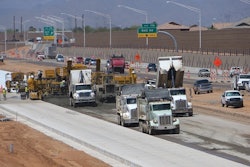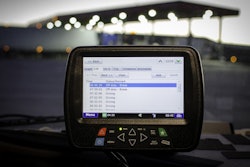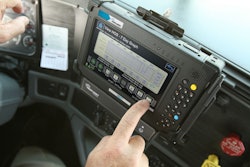
Brian Deery, senior director of AGC’s Highway & Transportation Division, said that over the next few months AGC will be talking with other industry groups about requesting some type of exemption from the Federal Motor Carrier Safety Administration. Deery said the main concern is that the ELD mandate and accompanying hours-of-service regulations lump in drivers in the construction industry with long-distance truckers.
“It all comes down to defining the types of drivers,” he says. He explains that drivers in the construction industry make frequent stops and are in and out of trucks dropping off and picking up supplies, in contrast to commercial carriers who are driving constantly.
Drivers can now be taken out of service
The mandate took effect December 18, 2017, for commercial motor vehicles subject to hours-of-service regulations, but full enforcement didn’t start until April 1.
The mandate requires replacement of paper logs with ELDs.
Agricultural-related transportation received a 90-day waiver from the regulations on March 19. Most other drivers of property-carrying motor vehicles, however, can be cited if they are stopped without a required registered ELD or a grandfathered automatic onboard recording device (AOBRD). They can now be placed out of service for 10 hours, according to the Commercial Vehicle Safety Alliance. Passenger commercial vehicles will be placed out of service for eight hours.
After the out-of-service period, drivers can continue to their destinations if they have documented their hours-of-service requirements with a paper record in a log book, daily log or log, and they have a copy of the inspection report and/or the citation, according to the alliance. If those drivers are stopped on the way, they must produce a copy of the inspection report or citation and proof they are continuing the original trip.
The alliance says all ELD violations will be counted against a motor carrier’s Safety Measurement System (SMS) score and trigger an investigation by the FMCSA’s Compliance, Safety, Accountability (CSA) program.
Construction industry ready for enforcement?
Deery says the ELD mandate and hours-of-service requirements are costly to the construction industry. Firms must install the ELDs on trucks and also have to pay monthly service fees. He adds that the mandate and hours-of-service rules are “not conducive to the types of driving our workers do.” Many of the devices are not geared for construction industry use, he adds.
But he believes the industry has made good faith efforts to implement ELDs and it is aware that it will face costly violations if it does not comply.
While acknowledging the backlash to the mandate, manufacturers of ELDs have been touting the other benefits of the devices to try to soften the blow.
Ryne DeBoer, vice president of Morey, which manufactures the MC-4 Series of ELDS, says the devices will ultimately save construction firms money.
One of the main benefits, he says, is they can “analyze real-time data from the vehicle’s ancillary accessories and communicate anomalies directly to the data center where it can be remotely viewed by contractors.”
“This helps construction firms streamline the decision-making process, improving fleet diagnostics and minimizing costly equipment downtime,” he says.
It should also save construction firms on insurance premiums, he adds.
Other benefits, he says, include the ability to “create a connected job site to improve time management, reduce loss or stolen equipment, and increase profits.”
Geo-fencing ELDs establish virtual boundaries around equipment that will trigger an alert when those boundaries are breached, he explains.
“Construction companies should also be aware that many ELD solutions allow for devices to be customized to fit specific needs,” he says. “So, if you need or would like to track a certain set of data that you feel will minimize cost, that feature can be added relatively easily.”
As to whether the construction industry is ready for the mandate, he believes there are still many stragglers.
“I don’t believe the industry as a whole has been preparing for compliance with the ELD mandate, because as with most regulations, it’s avoided until it’s passed and then everyone scrambles to get ready at the last second,” says DeBoer. “This procrastination most likely happened because the mandate wasn’t designed to bring maximum value to the construction market nor is it necessarily a core focus for contractors. Yet, they’re still required to comply because their vehicles fall under the larger blanket regulation.”
For more information on the ELD mandate, check out Equipment World’s comprehensive guide to the new regulations by clicking here.














